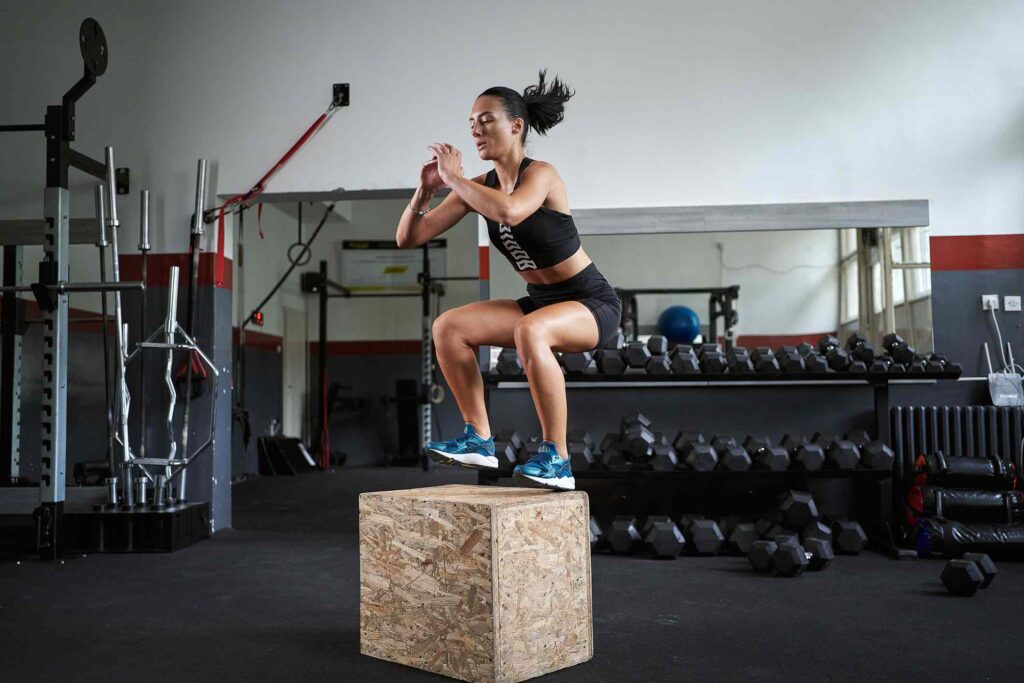:max_bytes(150000):strip_icc():format(jpeg)/Health-GettyImages-1278403727-1a96fcedd91442b0bc5f8938eb7d5d74.jpg)
Plyometrics is a type of exercise that involves quickly stretching and contracting muscles to create explosive movements with bodyweight resistance, increasing muscle power. Examples of plyometric exercises include burpees, squat jumps, and box jumps.
Plyometrics originated in track and field and was used by many athletes in Russia and Eastern Europe during training. It was often referred to as shock or jump training.
Purdue University’s track and field coach, Fred Wilt, coined the term plyometrics in 1975. “Plyometrics” combines the Greek words plyo or plythein (to increase) and metric (to measure). The term technically means to increase measurement. This may be demonstrated in sports through jump height, sprint speed, throwing distance or speed, and serving distance or speed.
Non-athletes who practice plyometrics may also reap significant health benefits from the exercise. There are a few things to keep in mind as you get started to ensure safety and maximize results.
Plyometrics are exercises that combine the speed and force of different movements to enable muscles to reach maximum force in a short period, building muscle power.
The stretching and contracting of the muscle fibers is called the stretch-shortening cycle (SSC). It involves alternating between eccentric muscle contractions—building up energy in your muscles—and concentric muscle contractions—releasing the energy.
The stretch-shortening cycle (SSC) consists of three phases:
- Eccentric: The loading phase where the muscle stretches, storing elastic energy and stimulating the muscle spindles (muscle length sensors)
- Amortization: The coupling phase that occurs at the end of the pre-stretch and before the concentric muscle action
- Concentric: The unloading phase, when muscle fibers shorten and release the elastic energy
Athletes often incorporate these movements into training because plyometrics training can improve your physical performance and ability. Athletes in sports like running, volleyball, or basketball may benefit the most from plyometrics.
Plyometrics are typically explosive movements that require a baseline fitness and coordination level. Less intense variations are sometimes used in rehab programs. To get the most benefit, it’s important to build a base of strength, balance, and stability.
Plyometric training can be a fun and challenging addition to training programs. To avoid injury, you’ll need to work up to certain exercises and skill levels, progressing systematically. You can work with a personal trainer or athletic coach to build a solid foundation, including motor control, eccentric strength, joint integrity, flexibility, and technical proficiency.
When you add plyometrics to your exercise routine, you may experience several physical health benefits. This can be particularly useful whether you enjoy running, playing basketball, or hitting the pickleball court. Here are some potential benefits of plyometrics.
Builds Muscle Power
Research has shown that adding plyometric training can give your muscles more power. A meta-analysis of 32 studies found that plyometrics cause muscles to stretch and contract more efficiently. When done consistently, this can improve muscle power.
Maintains Bone Health and Improves Balance
Regular plyometric training may promote bone health and balance, preventing falls and breaks.
A systematic review of 12 studies in older adults found that people who engaged in plyometric training had greater bone density in the femur (thigh bone), hip, and spine. The researchers also found that the plyometric participants experienced improved physical functioning, which could reduce falls and the risk of injuries.
Improves Agility
Most plyometric exercises are designed to train your muscles to make quick movements and build muscle memory. Research suggests that the more you practice these movements, the faster and more accurate your movements will become.
One study of basketball players found that the athletes were more agile and had better reaction times after eight weeks of plyometrics. Exercises that improve agility (like plyometrics) can strengthen connective tissues and reduce the risk of injury.
Boosts Running Speed
Originally an exercise for track and field athletes, plyometrics has been linked to improved running speed. One study found that young (age 13-14) male athletes who performed 15 minutes of plyometric training in addition to their regular training saw significant improvements in their 20-meter sprint times.
Another study on runners found that the athletes who participated in a five-minute plyometric hopping regimen every day for six weeks had significant improvements in their use of oxygen while running.
Plyometric exercises typically involve some combination of jumping, balance, and explosive force. Plyometric training is often used to train athletes or people with a high fitness level.
These exercises can be tough on your joints, especially the knees, so they may not be recommended for beginners. People typically use these exercises to complement their strength training. Talk with a healthcare provider or certified personal trainer before adding these exercises to your fitness routine.
Squat Jump
This exercise involves squatting down and then jumping up with explosive power. Here’s how it’s done:
- Stand tall with the feet shoulder-distance apart
- Lower your body into a squat position, keeping your bottom low and your chest upright
- Pull your elbows back and use your arms to jump up
- Reach your arms over your head as your feet leave the floor
- Land in the starting position
- Repeat
Lateral Bound
This exercise involves jumping from one foot to another while covering as much space as possible. Here’s how to do it:
- Stand tall with the feet shoulder-distance apart
- Pick up your right foot and jump laterally to the right as the arms come forward
- Land on the right foot as the arms come toward the sides, keeping balanced on the right foot
- Push off with your right foot to jump laterally to the left as the arms come forward
- Land on the left foot as the arms come toward the side, keeping balanced on the left foot
- Repeat
Split Squat Jump
This exercise involves jumping vertically while in a split squat position, then switching feet in the air before landing. Here’s how it’s done:
- Start in a split squat (or lunge) position with your chest tall (one foot in front of you with the leg bent 90 degrees at the knee, the other behind you, with the leg bent and knee close to the ground)
- Bend low and jump straight up
- Push evenly through both feet
- Switch feet in the air
- Land in the starting position with your foot placements reversed
- Repeat
Reverse Lunge Jump
This exercise targets your upper legs and glutes and combines lunging and jumping. Here’s how to do it:
- Stand tall with feet hip-distance apart
- Step the right leg back and touch the floor with the ball of the foot while the right arm comes forward
- Jump upward as you drive the right knee forward and reach the left arm overhead
- Repeat the first side for a few reps before switching
Plyometrics should be tailored to your abilities and needs. Working with a certified personal trainer can be beneficial, especially when starting out. They can evaluate your age, injury history, and basic foundational strength to determine which exercises are best for you. You should also talk with your healthcare provider to make sure you are cleared for this type of activity.
The most important equipment is a firm, padded landing space and high-quality training shoes. You should also have an established strength training routine. Beginners should consider starting with strength training before adding plyometrics. This will ensure your muscles are strong and can support plyometric movements.
During your plyometrics journey, you should see a gradual progression in the number and difficulty of plyometric exercises you can perform. It’s important not to load up on the most challenging movements right away.
Make sure to incorporate several days’ rest to allow for adequate muscle recovery. If you do not take these initial precautions, you risk serious injury that could derail your fitness goals.
If you’re considering plyometric training for your fitness regimen, you need to make sure your body is ready for it. Start slow and try to limit the number of contacts your feet have with the floor. This will help you avoid injury, including repetitive stress injuries.
Here are some other tips for maximizing your training and staying safe:
- Choose a forgiving surface: Choose a surface that will absorb the impact without causing injury, like a padded mat or a thick carpeted floor. Avoid jumping on concrete, tile, or asphalt.
- Warm up: Start with a simple, dynamic warmup for about five minutes, such as light jogging followed by high knees and butt kicks.
- Strength train: Combine plyometrics with other anaerobic movements like strength training. Try not to do them on the same day that you go for a run, which is an aerobic movement.
- Use a mirror: This will help you ensure you maintain proper form.
- Watch your landing: Your landing should be soft to absorb the force of the jump and reduce injury risk.
- Start low: Try jumping just a few inches at first and gradually increase the height. Eventually, you can add more challenging jumps, like box jumps, but do not try these right away.
- Avoid locking your knees: When you land, concentrate on bending your knees and not landing with your legs straight.
- Aim for two times a week: Because plyometrics can cause stress on your body, you should not do these exercises every day. Instead, add them a few times weekly so your body has time to recover.
Plyometrics is a type of exercise focused on quickly stretching and contracting muscles to produce maximal force in the shortest amount of time to increase overall muscle power. Athletes often use plyometric training to improve their jumping and running abilities. These exercises also improve agility, balance, and joint strength.
Non-athletes can also do plyometrics as long as they have built a foundation of strength. To get started, get clearance from a healthcare provider and work with a personal trainer for a customized workout plan.













